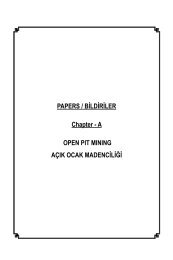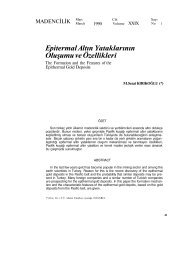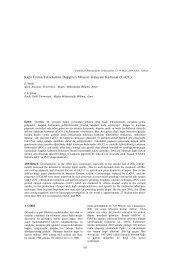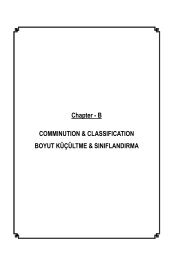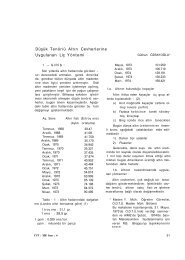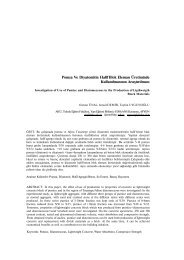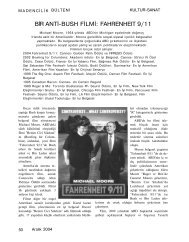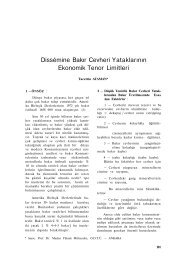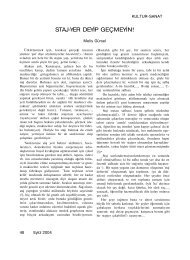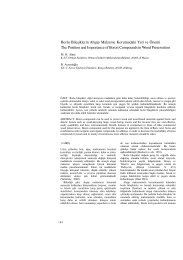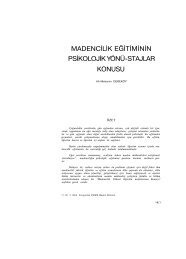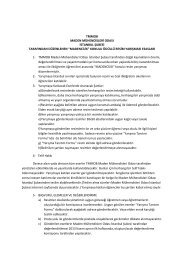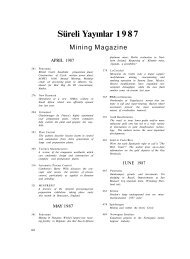Türkiye 14 Madencilik Kongresi / 14th Mining Congress of Turkey ...
Türkiye 14 Madencilik Kongresi / 14th Mining Congress of Turkey ...
Türkiye 14 Madencilik Kongresi / 14th Mining Congress of Turkey ...
You also want an ePaper? Increase the reach of your titles
YUMPU automatically turns print PDFs into web optimized ePapers that Google loves.
<strong>Türkiye</strong> <strong>14</strong> <strong>Madencilik</strong> <strong>Kongresi</strong> / <strong>14</strong>th <strong>Mining</strong> <strong>Congress</strong> <strong>of</strong> <strong>Turkey</strong>, 1995 , ISBN 975-.195-150-7<br />
PRESENT STATE AND DEVELOPMENT OF ENGINEERING BLASTING TECHNOLOGY IN<br />
CHINA<br />
Wang Xuguang<br />
Beijing General Research Institute <strong>of</strong> <strong>Mining</strong> and Metallurgy(BGRIMM), People's Republic <strong>of</strong> China<br />
ABSTRACT: This paper outlines the research, application and development <strong>of</strong> engineering blasting<br />
technology(such as chamber blasting, deep-hole blasting, underground mining blasting, underwater blasting,<br />
and urban demolition controlled blasting), blasting materials and blasting fundamentals in china.<br />
Engineering blasting, as a branch <strong>of</strong> science and<br />
technology, has been attracting wide attention and<br />
playing an important role in China. Under the<br />
guidance <strong>of</strong> the policy <strong>of</strong> "Reform and Opening to<br />
the Outside World" in recent ten and more years<br />
engineering blasting technology has rapidly<br />
developed in China, reaching an unprecedented level<br />
and providing extremely marked economic benefits.<br />
Its progress represents mainly in such respects as<br />
increasingly wider application to various branches <strong>of</strong><br />
the national economy with techniques gradually<br />
improved (Feng Shuyu, 1991); uninterrupted<br />
emerging <strong>of</strong> various new types <strong>of</strong> high efficiency and<br />
safe commercial explosives and initiating materials to<br />
adequately meet and prompote the modification and<br />
development <strong>of</strong> blasting technology (Wang Xuguang,<br />
1991,1995); fruitful results seen in research work on<br />
such topics as blasting fundamentals, methology for<br />
classification <strong>of</strong> rock blastability, blasting<br />
optimization design and mathematic modelling, safety<br />
and measuring techniques, capable <strong>of</strong> controlling<br />
blasting practice Moreover, elaboration and<br />
implementation <strong>of</strong> safety regulations, and young<br />
generation <strong>of</strong> blasting experts and their practical<br />
work have also laid down a solid foundation for<br />
further advance <strong>of</strong> China's blasting technology<br />
81<br />
The above mentioned aspects will be reviewed in<br />
this paper with outlook on the development in the<br />
years to come.<br />
1. INCREASING WTDE APPLICATION OF<br />
DIFFERENT ENGINEERING BLASTING<br />
TECHNIQUES TO VARIOUS BRANCHES OF<br />
NATIONAL ECONOMY<br />
1.1. Chamber Blasting<br />
Practice has shown that Chamber Blasting is a less<br />
investment, higher efficiency and faster realization<br />
technique, being widely used in China's mountainous<br />
areas to remove large volumes <strong>of</strong> rock. As early as in<br />
1956 it was introduced to mine capital stripping. For<br />
instance, that year the largest then in the world<br />
chamber blasting project was realized at the open pit<br />
mine <strong>of</strong> Baryon Nonferrous Metals Corp., Gansu<br />
Province, with a total explosive charge for three<br />
blasts amounting to 15,573t, total rock mass blasted<br />
9.07 Mm 3 , <strong>of</strong> which 2 27 Mm 3 thrown out <strong>of</strong> the<br />
pit outlines, enabling the mine put into operation two<br />
years ahead <strong>of</strong> schedule. Again in 1964, enforced<br />
loosening chamber blasting technology was adopted<br />
at the open pit mine <strong>of</strong> Jinchuan Nonferrous Metal<br />
Corp. to level <strong>of</strong>f several hills, with total explosive
charge 16SS t and 2.18 Mm 3 rock mass blasted, also<br />
ennabling this mine to enter operation one year ahead<br />
<strong>of</strong> schedule. This method has Widely been used to<br />
stripping projects at a number <strong>of</strong> open pit mines<br />
attached to metallurgy, building materials, chemical<br />
engineering, coal and other industries. For example,<br />
in the initial capital construction at the limestone pit<br />
<strong>of</strong> Shunchang Cement Plant a hilllevelling <strong>of</strong>f<br />
chamber blasting was carried out with multi-row<br />
quasi-plane charge pattern <strong>of</strong> 1708 t explosives,<br />
resulting in 1.22 Mm 3 rock mass blasted, 66% <strong>of</strong><br />
which thrown into the waste dump.<br />
Since 1958 the directional blasting techniques for<br />
dam building have been used in China. Up to now<br />
over 60 various kinds <strong>of</strong> stone dam, such as water<br />
reservoir dam, tailing dam, mud-rock flow protective<br />
dam, lime storage dam, etc. have been built with<br />
quite rich experience accumulated and calculating<br />
methods elaborated. For instance, at nanshui<br />
Hydroelectric Power Station a tatol <strong>of</strong> 1394 3 t<br />
explosives was consumed by directional blasting for<br />
dam building, resulting in 2.26 Mm 3 rock mass<br />
blasted and 62.5 M high dam formed by one blast,<br />
this initial dam was then upheld to 81.8 m and<br />
upgraded, which has been running quite well. During<br />
the Seventh Five Year Plan period frontier research<br />
work was done on piling up over 100 m high dams<br />
by directional blasting, providing theoretical and<br />
technological results. Again, at Jinshiyu Gold Mine,<br />
Hebei Province, a tailings dam was initially raised by<br />
directional blasting with equivalent and symmetrical<br />
charges on both sides <strong>of</strong> different altitude under<br />
unfavourable relief conditions. Its construction was<br />
completed nine months ahead <strong>of</strong> schedule and<br />
investment reduced by 55% compared with<br />
conventional dam building technology, and the<br />
stability <strong>of</strong> pioneer dam has been proved satisfactory.<br />
In construction <strong>of</strong> railways and highways chamber<br />
blasting is used primarily for rock work with<br />
maximum charge for one blast reaching over 400 t<br />
For example, in construction <strong>of</strong> such railway lines as<br />
Baoji-Chengdu, Yingtan-Xiamen, Chengdu-Kunming<br />
and Datong-Qinghuangdao chamber blasting<br />
techniques were employed to considerable extent<br />
with rock volume blasted 10.54 Mm 3 Especially in<br />
the past years single charge sequential millisecond<br />
blasting technology has successfully realized, thus<br />
ensuring safe operations under complicated<br />
circumstances In addition, directional blasting has<br />
been playing favourable role in dealing with slipping<br />
slopes.building <strong>of</strong> flood-diverting canals and levelling<br />
<strong>of</strong>f industrial sites, etc<br />
82<br />
It should be noted that replacing <strong>of</strong> concentrated<br />
charges by cylindrical or guasi-slabconcentrated<br />
charges has made marked progress in Chamber<br />
Blasting. Especially, sectional millisecond delay<br />
detonation techniques have been successfully applied,<br />
resulting in larger throwing distance and throw rate,<br />
more concentrated rock-pile and lower blasting<br />
vibration effect. For instance , in December 1985 at<br />
an asbestos mine in Sichuan Province the millisecond<br />
detonating system with multiple cylindrical charges at<br />
both sides <strong>of</strong> low and high altitude was successfully<br />
used to pile up a over 40 m high mud-rock flow<br />
protective dam <strong>of</strong> good shape, the effective throw<br />
rate reaching 63.5% and specific chargé for upper<br />
dam rock only 0.7 Kg/m 3 . Again in 1990 at Huizhou<br />
Port, Guangdong Province, directional blasting<br />
succeeded in building up a berth by filling the sea<br />
hannel with blasted rock. Adopting small plane slab<br />
charges in this blasting succeeded in the remote<br />
throw in slopping areas and in the refilling <strong>of</strong> a 230 m<br />
region between the beach and the island with<br />
throwing rocks. The throw efficiency was 63%.<br />
Rocks largely penetrated the silt with the maximum<br />
settlement up to 6 mm.<br />
1.2 Deep-hole Blasting<br />
Deep-hole Blasting techniques have been , widely<br />
adopted in the stripping engineering <strong>of</strong> open pit<br />
mines, deep-hole caving at underground mines,<br />
excavation <strong>of</strong> railway roads, levelling <strong>of</strong>f industrial<br />
sites in mountainous areas, and excavating caves for<br />
hydroelectric power stations, etc. in China.<br />
Deep-hole blasting for open pits includes large-scale<br />
multi-row millisecond delay blasting, tight-face<br />
blasting and small-burden large-spacing blasting, etc.<br />
However , in the adjacent slope areas, presplitting<br />
and smooth blasting techniques have been used to<br />
keep the stability <strong>of</strong> slope areas . The large-scale<br />
multi-row millisecond delay blasting technique has<br />
been spread and utilized in the large-scale open pits,<br />
such as Nanfen Iron Mine, Shuichang Iron Mine,<br />
Dexing Copper Mine, Open Pit <strong>of</strong> Jinduicheng Mo<br />
Industry Corp. Its bore-hole_ layout parameters,<br />
explosive loading structure, matching <strong>of</strong> the<br />
explosive for the properties <strong>of</strong> rock mass, initiation<br />
sequence and delay time, etc. have been thoroughly<br />
studied The blasting quality has been noticeably<br />
improved with fine techno-ecnomic performances<br />
For instance, comprehensive study has been<br />
undertaken at Nanfen Open Pit in the past years,<br />
which use
electric-wheel trucks. The delay blasting scale was<br />
500,000-800,000 t. The maximum scale 810,000 t<br />
was the first <strong>of</strong> its kind in the preloading charge by<br />
loading truck in China. At that time, SOS blasting<br />
holes were drilled, 270 t explosives preloaded, 104<br />
sections divided, the unit consumption <strong>of</strong> explosives<br />
0.9 Kg/m 3 , large block ratio 0.035% without pillars,<br />
The efficiency <strong>of</strong> electric shovel reached 1921 t/h<br />
Economic benefit was considerable. In addition, at<br />
this mine the program <strong>of</strong> blasting parameter<br />
optimization system was designed to calculate and<br />
predict the optimal parameters and blasting effect<br />
under different blasting conditions, then an<br />
optimization diagraph was elaborated for blasting<br />
engineering design work. It also adopted<br />
anisynchronous and sectional interference-vibration<br />
blasting, cutting down the vibration rate to 20-30%.<br />
Deep-hole Blasting has been also widely adopted in<br />
other fields. For instance , deep-hole sectional delay<br />
blasting, preslitting blasting, protective layer single<br />
blasting and non-protective layer blasting, etc. have<br />
been adopted in the base course excavation <strong>of</strong><br />
hydroelectric power stations, e.g. Gezhouba,<br />
Dongjiang, Chaishuitan, Dongfeng Power Stations.<br />
Especially, at Dongjiang and Dongfeng hydroelectric<br />
power stations horizontal presplitting blasting and<br />
horizontal presplitting plus deep-hole sectional delay<br />
sequence blasting have succeeded, demonstrating a<br />
new level <strong>of</strong> deep-hole blasting.<br />
1.3. Underground <strong>Mining</strong> Blasting<br />
Since early 1950's deep-hole blasting has been used<br />
for caving ores at underground mines in China<br />
Those mines adopting caving method generally use<br />
vertical or horizontal fan-like holes <strong>of</strong> 60-100 mm<br />
and 10-60 m deep for caving. The explosive loading<br />
for one blasting is from several tons to tens <strong>of</strong> tons<br />
even hundreds <strong>of</strong> tons with the maximum over 200<br />
tons. The blasting at the underground metal mines<br />
has been widely carried out by loading porous prilled<br />
ANFO and heavy ANFO by loaders, in conjunction<br />
with plastic detonating tube non-electric initiating<br />
system. While the reasonable bore-hole layout<br />
parameters, explosive loading structure and initiation<br />
sequence are selected, attention should be paid to the<br />
application <strong>of</strong> tight-face blasting, combination <strong>of</strong><br />
high-density and bottom loading <strong>of</strong> high-strength<br />
explosives in the vertical fanlike deep-hole blasting in<br />
order to improve the blasting quality Since the<br />
beginning <strong>of</strong> 1980's, VCR mining with spherical<br />
charge blasting has been studied and applied in a<br />
numder <strong>of</strong> nonferrous mines, such as Fankou Lead-<br />
83<br />
Zinc Mine and Shizishan Copper Mine <strong>of</strong> Tongling<br />
Nonferrous Metals Industry Corp., and furter<br />
developed into a combined blasting method in which<br />
the spherical charge is used for cut-<strong>of</strong>f stoping and<br />
column charge for ore breaking-up. This is a high<br />
efficiency safe mining method whicg has attracted<br />
attention <strong>of</strong> mining community. In addition, air<br />
isolation loading and interval initiation in holes,<br />
controlling <strong>of</strong> edge holes energy and reaction<br />
direction have been considered to reduce the breakup<br />
to sidewall. Work on mathematic modelling and<br />
parameter optimization for this mining system has<br />
made considerable progress.<br />
In the tunnel digging engineering, especially in the<br />
large-section tunnel digging blasting, horizontal<br />
deephole (5m in depth) blasting and uncoupling<br />
loading dmooth blasting in conjection with grouted<br />
bolting have been adopted widely to increase the<br />
digging efficiency and reduce excavation volume<br />
1.4 Underwater Blasting<br />
In the early 1970's the underwater blasting, the<br />
largest in that time, near the docks <strong>of</strong> Huangpu Port,<br />
Guangzhou, China was successfully carried out,<br />
making an underwater passageway with a width <strong>of</strong><br />
80 m and a depth <strong>of</strong> 9 m, through which ships <strong>of</strong><br />
10,000 tons can pass The total rocks crushed in 300,<br />
000 m 3 Along with the gradual increase <strong>of</strong><br />
construction projects <strong>of</strong> port docks and channel<br />
buildings, the scale and technique <strong>of</strong> underwater<br />
blasting have deen progressing continuously<br />
Underwater s<strong>of</strong>t base treatment is a difficult<br />
problem in port construction in China Since 1979, a<br />
series <strong>of</strong> underwater blasting has been undertaken<br />
successfully in the construction <strong>of</strong> Nanhai, Donghai<br />
and Qingdao Ports in China, and the blasting<br />
technique for some s<strong>of</strong>t base treatment has been<br />
formed In 1987 on the basis <strong>of</strong> modelling and<br />
mechanism research, a complete set <strong>of</strong> new methods<br />
for underwater s<strong>of</strong>t base treatment including<br />
explosion desludging and packing stones, explosion<br />
ramming, and underdyke explosion desludging, was<br />
successfully fulfilled in Lianyungang port and a great<br />
deal <strong>of</strong> systematic data and research achievements<br />
were obtained The practice shows that these new<br />
methods are adaptable to various underwater<br />
sludging base treatment, having the advantages <strong>of</strong><br />
simple construction and low cost<br />
In 1986, a 800 m long underwater concrete<br />
c<strong>of</strong>ferdam wall was successfully removed by blasting<br />
method at Gezhouba Hydroelectric power Station on<br />
the Yantze River, China The total explosive loading
in this blast was 47.76 t, more than 3000 holes<br />
blasted sequentially in 324 intervals <strong>of</strong> millisecond by<br />
adoption <strong>of</strong> double intersection connecting plastic<br />
tube non-electric initiation network to ensure 100%<br />
safe accurate blasting with satisfactory results.<br />
The newly constructed No 3 water source <strong>of</strong><br />
Zhengzhou Aluminum Industry Corp., Henan<br />
Province is at the beach <strong>of</strong> Yellow River. The<br />
distance from c<strong>of</strong>ferdam wall to pump station is only<br />
4 meters. Under such a circumstance, a three-row<br />
underwater deep holes in 16 intervals <strong>of</strong> millisecond<br />
blasting operation was fulfilled to break the waer<br />
intake dam and very good results were got.<br />
In addition, when water diverting tunnels are<br />
constructed around reservoirs or natural lakes, rock<br />
filling blasting method can be used at the water<br />
intakes to get fine techno-economic results. For<br />
instance, 4075.6 Kg explosives were used for the<br />
construction <strong>of</strong> Fengman Hydroelectric Power<br />
Station with a water storage <strong>of</strong> 30 m 3 , rock filling <strong>of</strong><br />
411 x 185 m.<br />
1:5 Urban Demolition Controlled Blasting<br />
In 1950's, blasting was tried in the urban demolition<br />
engineering in China. In recent years,, along with the<br />
rapid development <strong>of</strong> urban construction and<br />
continuous technical reform <strong>of</strong> enterprises, more and<br />
more abolished buildings, constructions (e.g.<br />
chimneys, water towers, bridges, abolished defence<br />
works, oil towers, industrial workshop bases, road<br />
bases, etc.) needed demolition. Meanwhile gradual<br />
perfection and popularization <strong>of</strong> controlled blasting<br />
provide technical and material base for the<br />
demolition work. At present, tens <strong>of</strong> engineering<br />
blasting companies distributed across China are<br />
undertaking various urban demolition blasting and a<br />
great amount <strong>of</strong> earth blasting. It is demonstrated<br />
that applying controlled blasting under complicated<br />
conditions to demolition <strong>of</strong> abolished buildings and<br />
constructions is a safe, simple, rapid and economic<br />
method which can control the collapse direction,<br />
stone flying, vibration and noise <strong>of</strong> the structure<br />
being demolished effectively to reduce the effect on<br />
the surrounding environment.<br />
The current demolition controlled blasting involves<br />
borehole blasting, hydraulicpressure blasting, outside<br />
blasting, static breaking by expanding agent and<br />
static pulling method. The first three methods are<br />
based on the selection <strong>of</strong> different explosives for<br />
blasting demolition. The later two adopt static<br />
stability-losing principle to fulfil demolition. In wide<br />
engineering practices, a lot <strong>of</strong> precious experience<br />
84<br />
has been accumulated on the hole layout pattern,<br />
loading structure and dosage calculation, selection <strong>of</strong><br />
explosives, determination <strong>of</strong> blasting instruments and<br />
sequence and safety protective techniques for various<br />
demolitions. At the same time, the mechanical<br />
process and stability-losing conditions <strong>of</strong><br />
decomposing, crushing and collapsing have been<br />
studied mechanically and survey and analysis <strong>of</strong><br />
harmful effect such as noise and earthquake <strong>of</strong><br />
blasting have also made.<br />
Engineering practice shows that most <strong>of</strong> the<br />
engineering blasting companies can control collapse<br />
sequence, direction and range accurately in<br />
demolition work even under a complicated<br />
environmental and strict requirement. For instance,<br />
the old building <strong>of</strong> Huaqiao Hotel in the business<br />
region <strong>of</strong> Beijing had a total demolition volume <strong>of</strong><br />
over 3000 m . Its main building had 8 floors <strong>of</strong> 34 m<br />
high totally. The two wing buildings had 7 floors <strong>of</strong><br />
28 m high totally. This was an extremely difficult<br />
demolition with very bad outer conditions. More<br />
than 6000 holes were drilled for blasting and more<br />
than 600 Kg explosives loaded for 9 intervals <strong>of</strong><br />
millisecond sequence blasting. The whole building<br />
collapsed according to predetermined direction and<br />
range so safety was ensured and designed blasting<br />
results were obtained.<br />
2 CONSTANT EMERGING OF SAFETY, HIGH-<br />
EFFICIENCY COMMERCIAL EXPLOSIVES<br />
AND BLASTING ACCESSORIES WELL<br />
MATCHING THE DEVELOPMENT OF<br />
BLASTING TECHNIQUES.<br />
2.1 Commercial Explosives<br />
At present, the annual consumption <strong>of</strong> commercial<br />
explosives in China amounts to 1, 000, 000 t. The<br />
main development <strong>of</strong> the commercial explosives in<br />
China can be displayed in three aspects, waterbearing<br />
explosives, powder and granulated<br />
explosives and relay detonating column.<br />
Generally speaking, water-bearing explosives are<br />
the general name <strong>of</strong> slurry explosives, water-gel<br />
explosives and emulsion explosives, the<br />
representatives <strong>of</strong> different developing periods.<br />
Since 1959, slurry explosives have deen developed<br />
in China. In the mid 1960's, they were popularized<br />
and utilized widely at some mines in Northeast China.<br />
In 1970's, its further development was recorded, but<br />
most <strong>of</strong> them were used for large-diameter(250mm)<br />
hole blasting at open pits.
Water-gel explosives were developed later. Until<br />
mid 1970's, China made water-gel exploives were<br />
unavailable. At that time, Huaidei Mines Bureau<br />
imported the production technology and equipment<br />
water-gel explosives from Du Port Corp., U.S.A. It<br />
promoted the development and application <strong>of</strong> watergel<br />
explosives in China. Generally, the production <strong>of</strong><br />
emulsion expliosves can be divided into continuous<br />
arid intermittent processes. Since later 1970's. the<br />
technology and equipment for intermittent<br />
production <strong>of</strong> emulsion explosives have been<br />
developed primarily due to the practical situaion <strong>of</strong><br />
equipment level and plenty and low cost <strong>of</strong> labour in<br />
China. The intermittent production equipment and<br />
process control formed have met the demand <strong>of</strong><br />
development <strong>of</strong> emulsion explosives in China<br />
satisfactorily and have its own characteristics. At<br />
the same time, contiunos production process annd<br />
equipment <strong>of</strong> capacity <strong>of</strong> 5000 t/y and 10, 000 t/y<br />
emulsion explosives annually were also successfully<br />
developed and put into commercial production. The<br />
series <strong>of</strong> emulsion explosives in China are various.<br />
Regarding the appearance, there are not only<br />
conventional s<strong>of</strong>t grease but also non-adhering to the<br />
container elastic type. Regarding density, there are<br />
not only general density explosives (1.05-1. 25<br />
g/cm 3 ) but also high density, high detonating<br />
velocity annd high strength explosives. Regarding<br />
utilization conditions, there are not only metallic and<br />
nonmetallic mine blasting explosives but also coal<br />
permissible explosives for mines with gas and coal<br />
dust explosion risk and petroleum exploration<br />
seismic focus column and low cost heavy ANFO<br />
explosives. The current explosives in China can meet<br />
the need <strong>of</strong> various engineering blasting. The future<br />
task is to establish sedation and standardization so<br />
that the clients can select the most suitable one<br />
according to different rock conditions, biasting<br />
meth<strong>of</strong>s and temperatures, etc.<br />
Experience has show that the effective measure to<br />
get more obvious economic pr<strong>of</strong>it from the blasting<br />
operation by water-bearing explosives is<br />
mechanization <strong>of</strong> loading. Although the slurry<br />
explosives were widely utilized in China in the mid<br />
1960s, the first set <strong>of</strong> slurry explosives pump truck<br />
and pumpable slurry explosives were available in the<br />
mid 1970's. However, emulsion explosive pump<br />
loading trucks and pumpable emulsion explosives,<br />
emulsion explosive mixing trucks and truck-made<br />
emulsion explosives have been developed in<br />
succession and put into application.<br />
Since mid 1950's, low-price ANFO explosives have<br />
spread and used in China. But before that time, the<br />
85<br />
used ANFO explosives were mainly powder ANFO<br />
explosives(i.e. using crystal ammonium nitrate, diesel<br />
oil, wood powfer as raw materials) and Ammonia<br />
Rosin-Wax explosives (using crystal ammonium<br />
nitrate, rosin and paraffin as raw materials). Along<br />
with the continuous increase <strong>of</strong> porous granulated<br />
ammonim nitrate and rapid development <strong>of</strong> emulsion<br />
explosive techniques, the meshanization <strong>of</strong> loading<br />
porous granulated ANFO and beavy ANFO as well<br />
as blasting holes have been spread and used. At<br />
present, ANFO explosives and Ammonia Rosin-Wax<br />
explosives used in China's metallic mines make up<br />
75-80% <strong>of</strong> the total output.<br />
The specific historical conditions make the powder<br />
ammonium TNT explosives (using crystal ammonium<br />
nitrate, TNT, wood powder as raw materials) still<br />
occupy a larger part in the commercial explosives in<br />
China. The main shortcomings <strong>of</strong> these explosives<br />
are noxious, easy to absorb moisture to form<br />
agglomerate, and lack <strong>of</strong> water resistance. In recent<br />
years complex oil phase materials and doudle surface<br />
active reagents, etc. with comprehensive sensibilizing<br />
and moisture protective properties are used to reduce<br />
the TNT content in ammonium TNT explosives and<br />
effectively solve the problem <strong>of</strong> moisture adsorption<br />
and blockage <strong>of</strong> powder ammonium nitrate<br />
explosives. Now a new Non-TNT powder<br />
explosives for rock blasting which can be compatible<br />
to No 2 rock ammomium TNT explosives has come<br />
into being. On the other hand, several new types <strong>of</strong><br />
low density, low detonating velocity, low strength<br />
powder explosives for smooth blasting have also<br />
been developed.<br />
Before 1978, thr blasting <strong>of</strong> slurry explosives in<br />
China was carried out by site-made RDX-TNT (1:1)<br />
primer, while ANFO in large diameter holes was<br />
usually blasted by about 1 Kg <strong>of</strong> No 2 rock explosive<br />
cartridges. The results were not very satisfactory.<br />
Recently, the relay blasting cartridges have been<br />
produced in special factories. There are various types<br />
such as PETN-, RDX-, and TNT Primer. Its<br />
appearance, weight, blasting power and<br />
predetermined middle holes, etc. can match the same<br />
kind products outside China. Additionally, some<br />
specific blasting instruments have been developed too,<br />
e.g. crushing bomb for flowing sand layer gravel,<br />
solving the problem <strong>of</strong> gravel crushing in sand<br />
drilling exploration.<br />
2.2 Blasting Accessories<br />
There are more than 40 commercial detonator<br />
manufauring plants in China, which manufacture
1,400 million pieces <strong>of</strong> commercial detonators per<br />
year, among which fire detonators account for about<br />
35- 40%, instantaneous electric detonators 35- 40%,<br />
millisecond delay electric detonators 15%, 1/4, 1/2<br />
and one second delay electric detonators 5%, nonelectric<br />
detonators 5%. there are usually 30 intervals<br />
in millisecond delay electric detonators and nonelectric<br />
detonators. The high accuravy millisecond<br />
delay non-electric detonators have isointervals.<br />
nominal secnd <strong>of</strong> the largest 30 interval is 1350<br />
milliseconds. In the last the years, several new<br />
products bave been developed.<br />
(1). Non-priming Explosive Detonator<br />
It is based on the principle <strong>of</strong> explosive burning<br />
changed into explosion. The first explosive loading <strong>of</strong><br />
detonators was cancelled owing to the reinforced<br />
inside constrained conditions The first non -priming<br />
explosive detonator production line was assembled in<br />
Dongchuan Mines Bureau in Yunnan Province,<br />
China. Its Products included both electric and nonelectric<br />
detonators. The millisecond detonators are 1-<br />
20 intervals, the second delay detonators are 1-7<br />
intervals and a series <strong>of</strong> products are available.<br />
(2). Safety Electric Detonators<br />
The safety is based on inserting a safety electric<br />
circuit between the legs and bridges <strong>of</strong> electric<br />
detonators. Its working principle is as follows.<br />
When the legs <strong>of</strong> electric detonators receive any<br />
outside electric energy signals, the signals are<br />
identified in the electric circuit. The electric circuit<br />
can identify static current, direct current or alterative<br />
current with a frequency lower than 1000Hz and<br />
refuses to transmit such signals to its bridges so the<br />
electric harm can be avoided. Only when the electric<br />
signal input matches the predetermined blasting<br />
signals, the electric current can go through the<br />
curcuit to its bridge easily and initiate the detonators.<br />
So the exotic electric harm is avoided and theh safety<br />
problems in blasting operation are solved. In addition,<br />
millisecond delay transmission instruments, relay<br />
blasters have also been produced in No 12 factory <strong>of</strong><br />
Fuxin Mines Bureau. Its products can be divided into<br />
single or double directional They usually have 6<br />
intervals<br />
Cable Blasting accessories usually include<br />
commercial fire fuses, detonating cords, and plastic<br />
detonating tubes. Although the delay <strong>of</strong> the<br />
commercial fire fuses is not exact, it can be<br />
combined with fire detonators easily and simply. Its<br />
86<br />
current annual consumption is about 500 million<br />
meters, including normal safety fuse and carbon fuse.<br />
The former has a combustion speed <strong>of</strong> 100-125 m/s,<br />
while the later 180-215 m/s. But the consumption <strong>of</strong><br />
the later is no more than 1/10 <strong>of</strong> the former, the<br />
annual consumption <strong>of</strong> the commercial detonating<br />
cords is approximately 30 million meters, including<br />
normal detonating cords, seismic detonating cords,<br />
coal mine detonating cords and petroleum well<br />
detonating cords. The four kinds <strong>of</strong> detonating cords<br />
have a unit explosive loading <strong>of</strong> 11-12 g, 37-38 g,<br />
12- <strong>14</strong> g and 30- 32 g or 18- 20 g respectively. The<br />
lead cover detonating cords are mainly used in the<br />
superdeep oil wells to initiate bombs. Plastic<br />
detonating tubes and non-electric detonators<br />
coordinate to form a non-electric detonating system.<br />
Because this system uses no electric energy to<br />
perform blasting operation and millisecond blasting<br />
can be carried out successfully as well as the<br />
production process <strong>of</strong> plastic detonating tubes are<br />
very simple, it has been widely applied in China and<br />
the application technique perfected continuously.<br />
Moreover, high temperature resistant (80-110)<br />
plastic detonating tubes have been developed<br />
recently to meet the demand <strong>of</strong> some special blasting<br />
operations.<br />
It should be noticed that some specially used<br />
blasting materials have been developed greatly, e.g.<br />
oil well perforating bomb. Its annual consumption is<br />
about 2 million pieces in China including gun or nongun<br />
types <strong>of</strong> various diameters. There are 24 models.<br />
The steel perforating bomb bas a inlet diameter <strong>of</strong><br />
(j)50 mm and perforation depth <strong>of</strong> 520 mm. Static<br />
crushing agents and high energy combustion agents<br />
have been successfully used in the engineering<br />
balsting, especially urban demolition blasting<br />
operation.<br />
3. GEAT SUCCESS HAS BEEN MADE IN THE<br />
FUNDAMENTAL STUDY ON BLASTING<br />
CAPABLE OF. GUIDING BLASTING PRACTICE<br />
It should be abmitted that the selection <strong>of</strong> parameters<br />
and blasting methods in the past were based mainly<br />
on experiences in the design and calculation <strong>of</strong><br />
engineering blastings. The reason is that there existed<br />
a certain gap between blasting theory and practive,<br />
But with the rapid development <strong>of</strong> modern<br />
technology and hard work <strong>of</strong> blasting engineers the<br />
basic theoretical study on blasting has achieved great<br />
success and can be used to guide blasting practices.
3.1. Blasting Measurement Techniques<br />
Along with the developnent <strong>of</strong> electronic technology,<br />
blasting measurement instruments become more and<br />
more abvanced. With help <strong>of</strong> these abvanced<br />
measurement instruments, various physical and<br />
mechanical parameters concerned with blasting can<br />
be observed, then the reaction laws on pressure<br />
shock wave, seismic wave, stress, strain and crack<br />
development in the related blasting region can be<br />
obtained after computer processing. For instance,<br />
DSVM-IA Vibration Measuring Device is a kind <strong>of</strong><br />
micro processor controlled vibrating measurement<br />
device based on calculation <strong>of</strong> the present values,<br />
having no signal transmission cables There channels<br />
<strong>of</strong> measurement and analysis results can be<br />
transmitted through several ex-parts or by numerical<br />
processing-information stored in the magnetic tape<br />
recorders. Then the quantative results are transmitted<br />
to a computer for analysis and processing . shock<br />
energy, bubble energy, total energy , pressure peak,<br />
shock value and energy density and other data <strong>of</strong> 34<br />
kinds <strong>of</strong> commercial explosives in China can- be<br />
measured and compared by underwater blasting<br />
energy measurement method. On this basis, taking<br />
into overall consideration <strong>of</strong> density, detonating<br />
velocity and related performances <strong>of</strong> explosives and<br />
rock characteristics provide conditions for the design<br />
<strong>of</strong> blasting mathematic modelling.<br />
Moreover, the development <strong>of</strong> blasting utensils in<br />
China has been very rapid, e.g. there are a series <strong>of</strong><br />
products <strong>of</strong> electric initiating devices with different<br />
blasting power, blasting electric bridges, stray current<br />
measurement devices, storm predicting devices,<br />
sound and optical numerical detonator measurement<br />
devices, intelligent detonating velocity measurement<br />
devices and laser blasters, etc.<br />
3.2.Theoretical Research on Blasting<br />
In the theoretical stufy <strong>of</strong> blasting, fragmentation<br />
effect and cracking mechanics in rock blasting have<br />
been combined together and the fragmentation<br />
mechanism, movement laws and parameter<br />
optimization have been studied with the application<br />
<strong>of</strong> mathematical modelling The stress state <strong>of</strong><br />
constructures can be analyzed by computer finite<br />
element method, especially the problem <strong>of</strong> dynamic<br />
and static stability losing <strong>of</strong> constructures when<br />
demolished by controlling blasting CAD <strong>of</strong> blasting<br />
has been achieved at Nanfen Open Pit Iron Mine,<br />
Shuichang Iron Mines and a lot <strong>of</strong> other metallic<br />
mines The research work on improving availability<br />
87<br />
<strong>of</strong> blasting energy <strong>of</strong> explosives, controlling energy<br />
trasformation process and ensuring safety, quality<br />
and economic results <strong>of</strong> engineering blasting has got<br />
noticeable progress. On the basis <strong>of</strong> extensive tests,<br />
methodsand standards <strong>of</strong> classifying blastability <strong>of</strong><br />
rocks have been formulated.<br />
3.3. Numerous Safety Regulations Have Been<br />
Worked out and Implemented to Guide Blasting<br />
Practice<br />
Since 1978, the related responsible departments in<br />
China have organised the nationwide famous blasting<br />
experts to formulate and issue Blasting Safety<br />
Regulations, Bulk Blasting Safety Regulations,<br />
Urban Demolition Blasting Safety Regulations,<br />
Regulations <strong>of</strong> Checking Blasting Personnel Safety<br />
Techniques, etc. The related industrial departments<br />
have also worked out their own regulations, such as<br />
Safety Regulations for Metallic Mine Blasting and<br />
Explosive Production <strong>of</strong> the Ministry <strong>of</strong> Metallurgy,<br />
Safety Regulations <strong>of</strong> Coal Mme Blasting <strong>of</strong> the<br />
Ministry <strong>of</strong> Coal Industry. They have not only<br />
obeyed the national requirements but also specialized<br />
the pr<strong>of</strong>essional specific situations. At same time, the<br />
related presses have edited and published many<br />
monographs, eg.'Ttocfc Crushing Mechanics",<br />
"Emulsion Explosives", "Slurry Explosives: Theory<br />
and Practice", "Ammonium Nitrate Explosives",<br />
"Engineering Blasting", "Bulk Blasting", "Blasting<br />
Calculation Manual", "New Technology for<br />
Demolition Blasting", etc. The journals published are<br />
"Engineering Blasting", "Blasting" and "Blasting<br />
Material". Moreover , China Sosiety <strong>of</strong> Engineering<br />
Blasting holds one conference every four years and<br />
publishes its proceedings. Four proceedings have<br />
been published till now. The first International<br />
Engineering Blasting Conference was held in Beijing<br />
in 1991, its proceeding was published both in English<br />
and Chinese. The second International Engineering<br />
Blasting Conference will hold in Kumming in 1995.<br />
China Society <strong>of</strong> Engineering Blasting has<br />
coordinated with organizations <strong>of</strong> public security,<br />
metallurgy, coal industry, water supply and<br />
hydroelectric power and railways to hold;various<br />
specific workshops for training. It is shown<br />
practically that the trained technicians and workers<br />
are playing better part in various engineering blasting<br />
operations<br />
4 FUTURE DEVELOPMENT
The author has discucced with a number <strong>of</strong> well<br />
known experts both in and outside China on the topic<br />
<strong>of</strong> further development <strong>of</strong> engineering blasting<br />
technology in China and got numerous instructive<br />
comments A summary <strong>of</strong> those comments is given as<br />
follows:<br />
4 1 In respect <strong>of</strong> industrial explosives priority should<br />
be given to the R & D <strong>of</strong> porous prilled ANFO,<br />
emulsion (including permissible type for coal mines)<br />
and heavy ANFO explosives with uninterrupted<br />
expansion <strong>of</strong> their application scope and proportions.<br />
Especially, research works should be speeded up to<br />
develop new kinds <strong>of</strong> emulsion explosives with<br />
quality improved, and lighter, more compact<br />
equipment and higher efficiency technology for<br />
producing emulsion explosives Efforts should be<br />
made in order to by 2000 replace all toxic powdered<br />
AN-TNT explosives by the above-mentioned three<br />
types <strong>of</strong> mining explosives in ferrous, nonferrous,<br />
building materials and other non-coal mines.<br />
Regarding initiating materials it is necessary to<br />
improve and widely use plastic detonating tubenonelectric<br />
detonation system and enhance its<br />
reliability and flexibility. While increasing the number<br />
<strong>of</strong> intervals for electric detonators and their precision,<br />
we should develop the techniques and products <strong>of</strong><br />
non-primary and safty electric detonators. In addition<br />
efforts should be made to develop the technique and<br />
equipment for site mixing-loading <strong>of</strong> explosives,<br />
especially emulsion and heavy ANFO explosives in<br />
both open pit and underground blasting . Such<br />
technique is preferred to use in combination with<br />
plastic tube-nonelectric detonation system so as to<br />
gain optimal blasting effect and safety.<br />
4.2 As mentioned above, quite rich experience has<br />
been accumulated in such aspects as chamber, deep<br />
hole, underground and underwater blasting as well as<br />
demolition controlled blasting with satisfactory<br />
success in China . However , regarding the whole<br />
labour productivity China remains rather behind<br />
U.S.A., Canada and other developed countries.<br />
Therefore, efforts should be made in developing high<br />
efficiency drilling and blasting mechanics with more<br />
advanced mechnization. At the same time CAD<br />
should be widely applied in blasting design work in<br />
order to further improve its precision and reliability.<br />
In addition , futher research must be done in such<br />
fields as fracture controlling blasting technology,<br />
theory on blasting crater and measuring techniques,<br />
and classification <strong>of</strong> rock blastability in order to put<br />
88<br />
the research results to real application at earlier<br />
possible stage.<br />
4.3 In respect <strong>of</strong> blasting fundamentals research it is<br />
a must to enhance the applied work on blasting<br />
mechanism and mathematic modelling on the basis <strong>of</strong><br />
existing achievements. Regarding the former, it is<br />
necessary to use new measuring techniques such as<br />
moving optical bullet, moving cloud point, distance<br />
seismic wave measurement, X-ray pulse photography,<br />
high speed photography and computer programming,<br />
and further research on quantitative analysis <strong>of</strong><br />
blasting dynamic charge and the complicated stressstrain<br />
field <strong>of</strong> blasting in heterogeneous medium, and<br />
put the research results to application. In respect <strong>of</strong><br />
the later, it is preferable, on the basis <strong>of</strong> surveying the<br />
worldwide mathematical modles, to employ<br />
computer techniques, image analysis and fuzzy<br />
identification in order to search for regularities and<br />
shrink the gap between the mathematic modelling<br />
and blasting practice.<br />
REFERENCE<br />
Feng Shuyu etc., 1991. Proceeding <strong>of</strong> The<br />
International Conference on Engineering Blasting<br />
Technique, Peking University Press, ppl-10,<br />
Beijing.<br />
Wang Xuguang, 1991. Proceeding <strong>of</strong> The<br />
International Conference on Engineering Blasting<br />
Technique, Peking University Press, ppll- 20,<br />
Beijing.<br />
Wang Xuguang, 1995. Emulsion Explosives, The<br />
Metallurgy Industry Press, Beijing.



